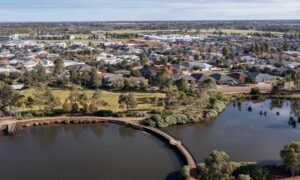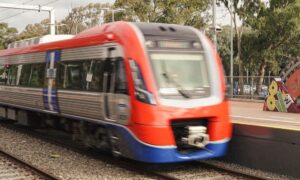 Presented by Soundstream Collective
Presented by Soundstream Collective
Reviewed Friday 30th September 2011
http://www.soundstream.org.au/2011/09/inaugural-concert/
Venue: Elder Hall, University of Adelaide, North Terrace, Adelaide
Season: One performance only
Duration: 1hr 30min incl interval
Following a welcome from Artistic Director, Gabriella Smart, and an introduction from Professor Michael J. Brooks, Deputy Vice-Cancellor (research), Steve Reich's minimalist piece, Clapping Music (1972), opened the concert, with seven performers working as two groups rather than just the usual two performers. One group claps a constant 12/8 rhythm, based on the African bell pattern (with one added beat), while the other does the same, but shifts by one beat every so often until finally coming back in unison. This lighter work was a popular piece with the audience and fun for both listeners and performers.
Next came the longest composition on the programme, Erik Griswold's A Leaf Falls, for cello and percussion quartet. Having studied at the Elder Conservatorium as a percussionist myself, I am well aware of the difficulties Elder Hall creates with its rather live acoustics. Well suited to most instruments, it tends to muddy percussion performances due to the echo, as we heard in this piece. This work had an interesting staging, with the Vortex Percussion Ensemble, Ryan Simm, Jamie Adam, Ryan Harrison and Andrew Wiering, forming a semicircle around cellist, John Addison, with the left pair forming a mirror image of the right pair. The inner pair upstage both had instruments including snare drum, large tom tom, bass drum, glockenspiel and woodblock, the outer pair downstage both had instruments including vibraphone and cymbals. This allowed for four individual sources of sound, as soloists and in numerous combinations, with the pairs either playing in unison, creating counter-rhythms or passing the rhythms to and fro between them. The cello, too, adds a percussive effect by playing several col legno phrases, as a contrast to very lyrical coll'arco passages. Ultimately, though, it said everything to me in the first section and, in spite of Addison's superb playing and the intricate work of the Vortex Quartet, I felt that it kept repeating its message in the later movements and had little more to say.
After rearranging the stage, we heard Esa-Pekka Salonen's Meeting, for clarinet and piano, with Stefan Ammer on piano and Peter Handsworth on clarinet. This piece is an extended musical conversation between the two instruments, inventive, complex, sometimes percussive, with occasional unison passages suggesting that the meeting is mutually rewarding. The fine performances from both musicians, with an obvious congruence of ideas, constitutes another meeting.
Hanna Kulenty's A Sixth Circle, for trumpet and piano, closed the first half. Trumpeter, Martin Phillipson, plays with and without mute during the performance, often playing into the piano to generate a resonance from the strings, differing in quality depending on whether or not his instrument is muted. Unfortunately this was hard to hear and, as Gabriella Smart entered quickly after these moments, the piano ended those resonances before the ear could properly adjust to them. There is an excellent balance between the two performers, and a clear agreement on the interpretation as they work through the many short motifs in this minimalist piece. This is possibly, though, a work better suited to a more intimate venue that enables those subtleties to be heard more clearly.
After the interval there were two short pieces, beginning with John Polglase's Shining, unbreakable, for violin and piano, with Elizabeth Layton and Gabriella Smart. These two instruments always sound wonderful together and this piece is no exception, with an almost symbiotic relationship existing between these two fine performers during this intricate work.
Closing the concert was the Natascha Trio adapted from his opera, The Three Sisters, by Peter Eötvös. The opera is based on the play by Anton Chekhov. This piece is written for piano, violin, clarinet and soprano, the only work on the programme including a vocalist. The trio consisted of Smart, Handsworth and Layton, and the soprano was Sidonie Henbest.
Natasha was the thoroughly unpleasant, self-centred immature, not very bright, lacking in taste and socially unacceptable girl from the village who ensnared the brother of the three sisters, married him and then took everything that the family owned. Eötvös conveys all of that unpleasantness in his music, brilliantly realised by the three musicians, and Henbest sings the Russian text with a good understanding of the character informing her marvellous performance. This was a tremendous ending to a most worthwhile inaugural concert from the Soundstream Collective.
Reviewed by Barry Lenny, Arts Editor, Glam Adelaide.




















